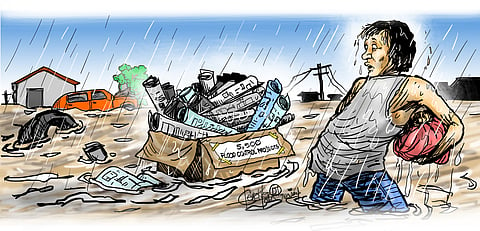
- NEWS
- the EDIT
- COMMENTARY
- BUSINESS
- LIFE
- SHOW
- ACTION
- GLOBAL GOALS
- SNAPS
- DYARYO TIRADA
- MORE

It hasn’t even been four months since President Ferdinand Marcos Jr., in his grandiose third State of the Nation Address (SoNA), regaled us with tales of his administration’s triumphs, including a reported 5,500 flood control projects constructed.
With a number that high, you’d think we’d have achieved some level of water management wizardry by now. But here we are, drenched and drenched again, as recent storms like tropical storm “Kristine” have tested that infrastructure — and found it wanting.
As Luzon and Bicol reeled from recent floods, the President admitted that his much-lauded flood control infrastructure wasn’t enough to withstand “unprecedented weather events.”
In the delicate language of politics, that’s a real twist, effectively transforming his once-proud flood control projects into yet another “we tried, but…” in the annals of Philippine governance.
This pivot, barely months after his own accomplishment report, raises a few questions: Are these 5,500 projects a flimsy defense against nature’s fury, or were they never designed to tackle real-world flooding in the first place?
The number certainly sounds impressive, and there’s no doubt some of these projects may have mitigated flooding to a degree. But there’s a difference between quantity and quality — a difference made glaringly obvious by the torrents that swept through our streets, towns and fields.
“Flood control” shouldn’t be about counting projects; it should be about the actual efficacy of those projects. If 5,500 projects can’t handle what’s become predictable weather behavior, then are they flood control projects, or just placeholders?
President Marcos’s acknowledgment that the infrastructure wasn’t enough has done little to appease critics, who feel these recent storms exposed a gap between what was promised and what was delivered.
The President’s flood control report was grandly painted as part of the nation’s fight against climate change, portraying his administration as proactive and future-focused. However, his recent admission shows an administration playing catch-up, dealing with damage control and “resilience” rather than true climate adaptation.
To be fair, extreme weather patterns are undeniably becoming more frequent and intense, thanks to climate change. But given the Philippines’ long history with typhoons and flooding, extreme weather isn’t exactly “unprecedented” to us.
Flooding is practically a national tradition, with each season offering its own water-themed disaster. If our leaders are aware of this — and Marcos Jr. certainly seemed to be during his SoNA — then why the scramble to reassess mere months after a victory lap on flood control?
This isn’t just about adapting to climate change; it’s about an honest assessment of whether existing infrastructure is up to the task.
The irony of all this, of course, is that while the President has no qualms about touting his achievements in public, his willingness to admit shortfalls after the fact is a familiar political maneuver: claim success when it’s convenient and plead limitations when things go wrong.
The public, however, is growing weary of this back-and-forth. The Marcos administration isn’t the first to over-promise and under-deliver on climate resilience. It’s a recurring theme that Filipinos have seen from one administration to the next, often resulting in frustration and a resigned kind of cynicism.
The flood crisis following “Kristine” is a potent reminder that infrastructure reports filled with big numbers and confident assertions don’t necessarily translate into real-world protection. It serves as a wake-up call, too, for future administrations and policymakers that genuine resilience isn’t built on tallies of construction projects alone.
The promise of 5,500 flood control measures may sound reassuring on paper, but as the waters rise, the real measure of success is in outcomes, not press releases.
In the end, if we truly want flood control that works, it would require more than just “not enough” projects. It demands a commitment to do more than announce achievements and celebrate half-done successes. It requires action that endures beyond the next SoNA.
